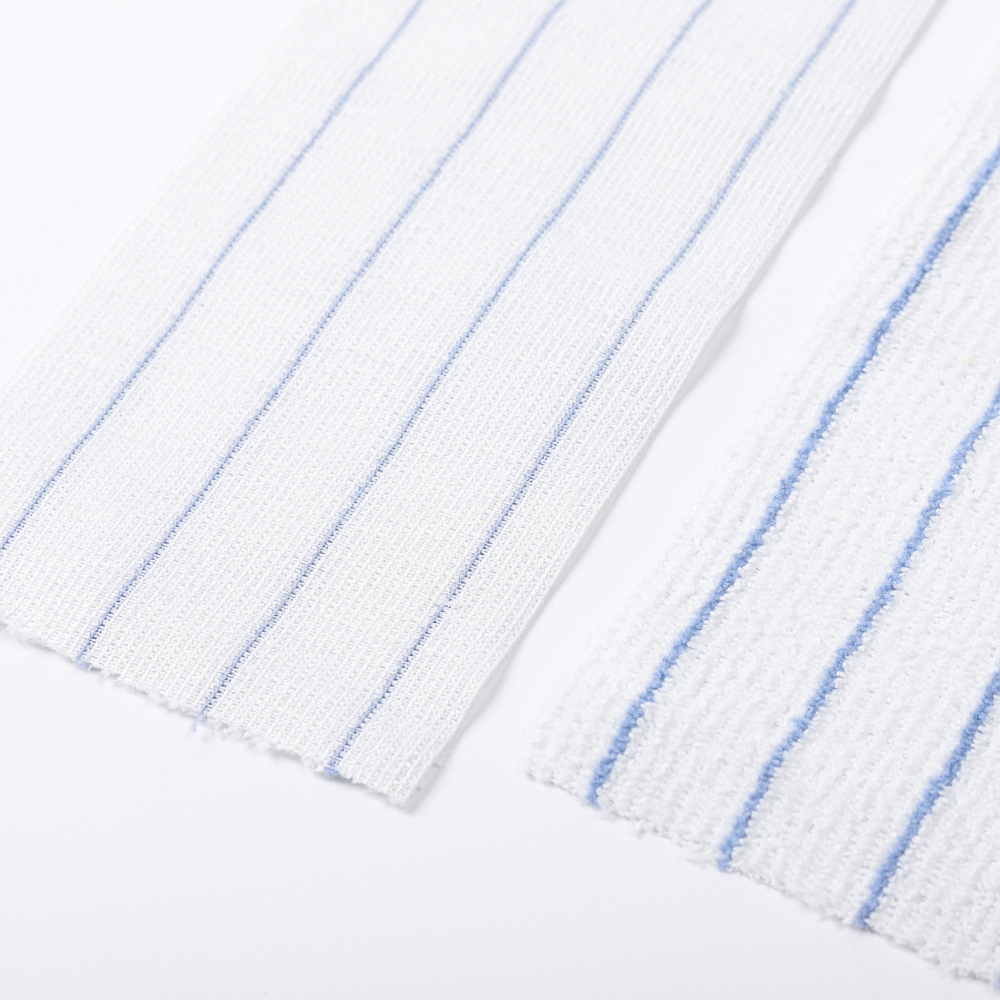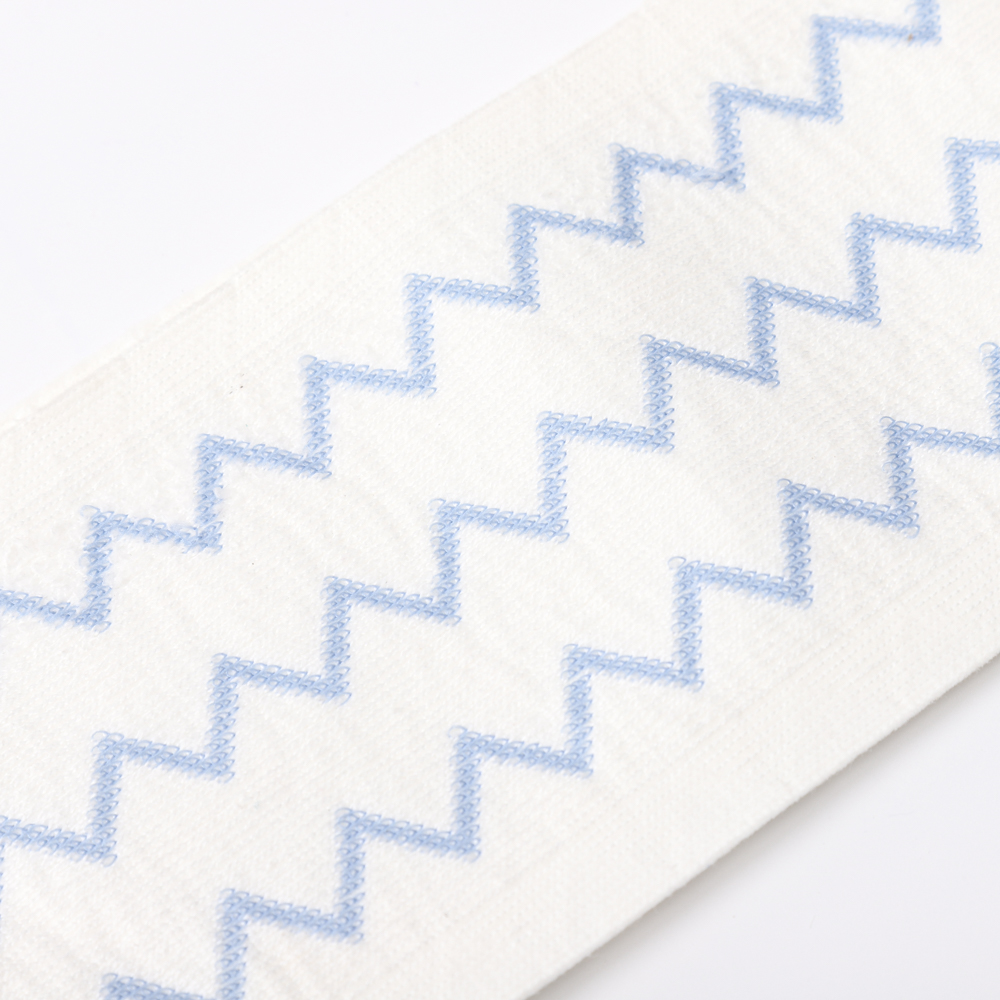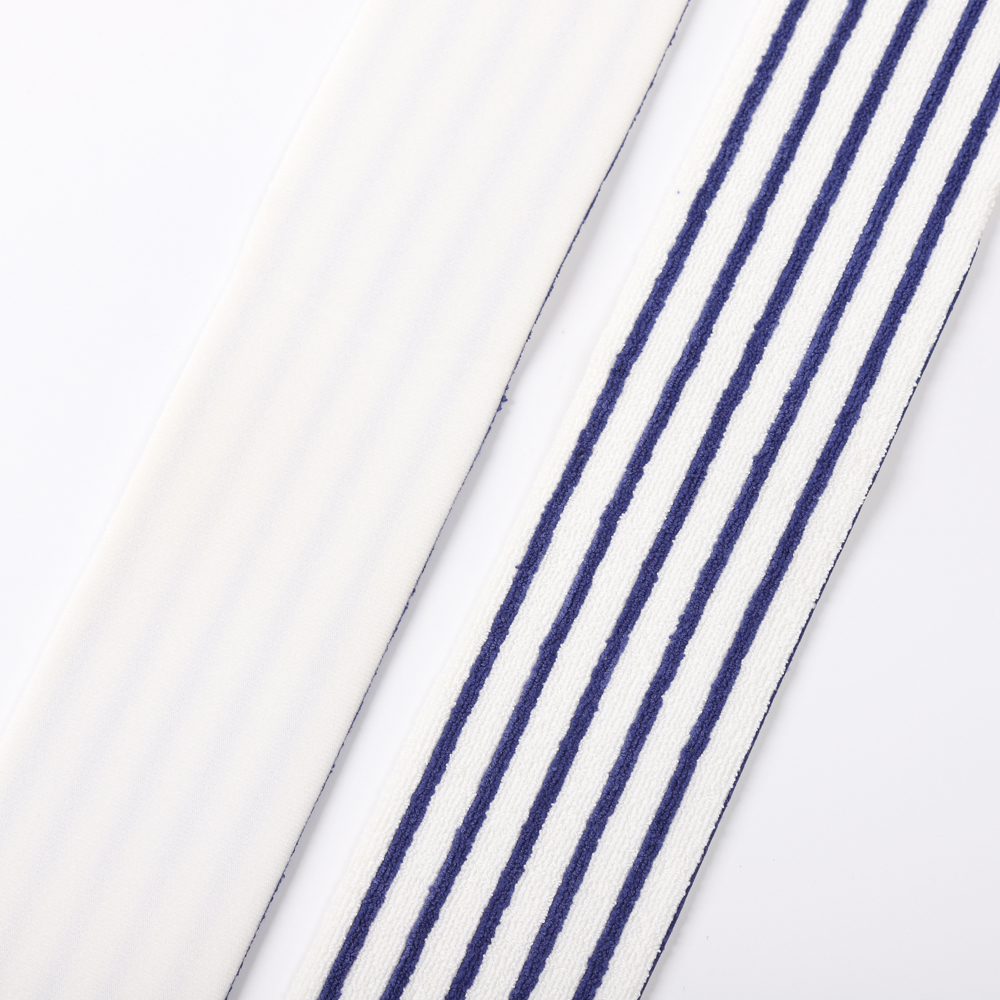Disposable mops are a one time use products,They are the products made by 100% non-woven cloth or very cheap cleaning fabrics that just can use a short time.
Disposable mops will cost you less on initial purchase but are also a one-time use product.with low costs and after used will damage.use a disposable mop will not have any soil build-up or chemical residue from previous cleaning procedures. Disposable Microfiber Mops can increase your worker`s productivity and reduce labor costs. While you use reusable Microfiber Dust Mop or Microfiber Tube Mop,we need wash after each time.
In simple terms, a gravure printer consists of the following components:
1. The composition of a plate cylinder 2, a rubber impression cylinder 3, an ink tank 4, a doctor blade 5, an ink drying device, a gravure cylinder, and a gravure plate cylinder are mainly composed of the following parts:
1. The roller body, also called the roller core, is the support body of the plate cylinder.
2. Electroplated copper layer, which has a great influence on the service life and performance of the plate cylinder.
3, the surface of the chrome plating layer: greatly enhance the printing surface hardness, wear resistance, chemical stability and other printability, thereby enhancing the resistance to printing force. Otherwise, the plate cylinder is liable to cause damage during the printing process.
If the ink and squeegee used are suitable for the roller, the desired effect will be obtained after printing. In today's gravure printing industry, there are basically two types of drum engraving methods: chemical etching and electronic engraving. Among them, the most commonly used chemical etching method is the direct transfer method, but with the development of electronic engraving technology, this method has gradually withdrawn from the stage of history. Regardless of which of the above engraving methods is used, the same roller body is used.
After the steel or aluminum alloy roll body is polished and polished, it must be plated with copper, chrome plated, and then polished, and then it is ground to a predetermined size. People always hope that the same batch of drums will be 100% identical in size, but in reality this is difficult to achieve, and there will always be an error of a few thousandths of an inch.
Therefore, it is easy to see that the diameter of the roller is a very important parameter. If the two rollers are not the same size, for example, a difference of 0.0002 inches, then the circumference of the two rollers will be almost different by 0.0006 inches. In a gravure printing machine, if a larger sized cylinder is placed in the former color group and a smaller sized cylinder is placed in the rear color group, the printing stroke traveled by each large sized cylinder is smaller than the small size. The drums are longer, and this will inevitably result in overprinting.
The printing color sequence is arranged in the gravure printing of the web material. The registration between the different colors depends on the linear speed of the cylinder and the tension. In theory, the diameter of all platens should be exactly the same, and it is entirely possible to use a modern polishing device. If the diameter of the plate cylinder is deviated, the operator should place the plate with the smallest diameter in the first color group, and the plate with the largest diameter should be placed in the last color group. That is to say, the first color is printed first with a roller having the smallest diameter, and the last color is printed with the roller having the largest diameter, and the two are arranged in ascending order. It should be noted that the error we are talking about here is an error of a few thousandths of an inch.
The printing color sequence used for surface printing is generally from light to dark, that is, according to the order of the colors from light to dark, the printing color sequence is arranged, the light color is printed first, and then the printing is dark color, basically yellow (Y)è magenta ( M)è Cyan (C)è Black (K) order. In the printing process, the color sequence of the printing is the opposite. The dark color is printed first and then the light color is printed. That is, black (C) è magenta (M) è yellow (Y).
The engraving of the platen roller attaches the manuscript to the scanning roller. The scanning head scans the manuscript. At the same time, the scanning head sends a pulse signal to the computer. The computer drives and controls a hexagonal pyramidal engraving head in a certain order in the copper plated version. Draw the dots at the corresponding position on the drum.
The hexagonal pyramid-shaped carving knife sculpts an inverted pyramid-shaped mesh on the surface of the plate cylinder. The opening of the mesh cavity can reach a maximum of 200 microns (0.008 inches) and the maximum depth can reach 50 microns (0.002 inches). .
The actual volume of the electronically-engraved net hole is about 30% smaller than the volume of the net hole formed by the chemical etching method. However, there are other factors, such as the greater the opening degree of the electronic engraving net hole, the release property of the ink. The better, so that it can compensate for the lack of network space to a certain extent.
In the field of the image, the electronic engraving machine can also engrave a channel between the cells, improve the fluidity of the ink in the cells, and greatly improve the ink transfer performance of the plate cylinder, thereby obtaining a smooth ink film in the solid area.
The role of the squeegee is to scrape off excess ink on the surface of the gravure cylinder. If the adjustment is correct, the squeegee blade should leave only the ink in the cell (image part), and the excess ink on the surface of the platen roller (not in the graphic part) should be scraped clean.
The meaning of “scrape†means that during the movement of an object, it is broken by the action of an external force. In the process of scraping ink, the continuously running drum drives the ink to move, and the pressure of the squeegee is the external force.
In order to scrape the ink from the surface of the plate cylinder, first, the squeegee must penetrate the ink film. Only the edge of the squeegee can do this. Therefore, the way the squeegee is in contact with the plate cylinder is very important. Such as the angle of contact, the squeegee edge, and the size of the applied pressure.
Due to the limitations of the structure of the printing press and the relationship of the printed images, the range of motion of the doctor blade is limited. If the size of the plate cylinder that is applicable to the printing press is relatively wide, the scope of the squeegee mechanism can be relatively large, and vice versa.
The squeegee blades and the support blades are usually mounted in a squeegee blade. The squeegee blade can be removed from the printing press, or a pre-machined squeegee blade can be mounted directly in the squeegee blade without having to be removed from the printing press before installation.
Straight-line installation scrapers have been used for many years. They work well on narrow-bore gravure printing machines, and the installation of scrapers is relatively simple. After installation, scrapers generally remain flat and do not bend. However, if a straight scraper is used in a wide gravure printing machine, installation is not so easy. Due to the relatively long squeegee blade, bending deformation often occurs. In order to solve this problem, a curved blade was introduced. In fact, this kind of scraper itself is not curved but straight, but with the bending of the blade holder and the pressure, the squeegee will bend. In some cases, it is also possible to use only a doctor blade instead of a pressure blade.
There is also a squeegee-type squeegee blade holder. This type of squeegee holder can release the squeegee blade very quickly and can control its movement through an eccentric shaft or a pneumatic piston.
Common Tip Scraper Compared to the Cross Section Scraper There are two types of squeegee blades: an ordinary tip squeegee and a cross section squeegee. A cross section squeegee is commonly used.
Cross section type squeegee The general tip type squeegee cross section type squeegee has a long service life. Since the processing point of the blade and the contact portion of the roller is very precise, the squeegee is accurate. Although the squeegee blade wears continuously during the printing process, the contact area remains constant throughout the length of the squeegee, and therefore, the gradation of the printed image does not change.
Ordinary tip squeegee blades have a limited service life. Since ordinary squeegee blades are pre-grown, only the blade edge of the squeegee can touch the platen roller. With the progressive wear of the blade, the cross-sectional area of ​​the contact portion is also continuously increased, which is very disadvantageous to the scraping of the ink and causes the change in the value of the gradation of the printed image. In this case, in order to ensure the consistency of the print, the squeegee must be constantly adjusted.
Cross-section squeegee:
1. The service life of the cross-section squeegee is seven times that of the ordinary squeegee.
2. Since the contact area between the cross-section squeegee and the plate cylinder is always kept constant, it is also possible to ensure that the squeegee pressure is constant and consistent.
3. Even if the squeegee wears out, it will not have any effect on the printing tone.
4. The pressure of the squeegee can be kept at a minimum, therefore, the wear of the squeegee is reduced, and the service life of the platen is extended.
Ordinary pointed squeegee:
1. The replacement of the squeegee blade will inevitably increase the downtime of the equipment. Moreover, after the blade is replaced, the printer will be restarted and printed. This will also result in waste of materials, each time.
2. Re-adjusting the tone value also takes a certain amount of time.
3. When replacing a job, you also need to replace the doctor blade.
4. Whether it is an old squeegee blade or a new blade, it must be re-polished before it is put on the machine.
The angle of the squeegee blade is the same for both the straight squeegee and the curved squeegee. The optimal angle of contact between the squeegee and the plate is 60 degrees. This angle ensures that the squeegee can The excess ink on the surface of the roller is scraped clean.
We can see this straight line: the straight line that connects the contact point with the center point of the plate cylinder. The angle between the scraper axis and this line is generally called "SetAngle". This angle should be set when the platen is at rest and has not yet applied pressure to the squeegee. It is usually used as a parameter for printing press control. This angle will change slightly when pressure is applied to the squeegee. In particular, when using a straight squeegee, the change in angle is slightly more noticeable. The change in the use of a curved squeegee is relatively Smaller because the curved squeegee bends toward the drum under pressure. In general, angles between 10 and 40 degrees are suitable for most presses.
Squeegee position The squeegee position is determined by the doctor blade and the embossing point. That is, the squeegee position is the distance from the squeegee contact point to the embossing point on the platen roller. There are many factors that determine the position of the squeegee, such as the speed of the printing press (depending on the drying speed of the ink). If the printing speed is slow and the drying speed of the ink is fast, the distance between the squeegee and the printing point should be Closer.
The pressure of the squeegee is to keep the contact pressure between the squeegee and the plate cylinder as light as possible while ensuring that the ink is effectively scraped and the amount of ink is controlled. When replacing a new job, it should also be replaced with a squeegee, and it should be fixed at a predetermined position and set the squeegee angle.
After the squeegee blade is installed, the ink circulation system is also opened so that the drum can run for a while at a certain speed. The purpose of this is mainly to eliminate the adverse effects of any minor defects (such as cracks, nicks, burrs, etc.) on the squeegee blade edge. If you look at the cells on the plate cylinder with a microscope, you will find that the edges are very rough. These burrs are only wearing the edge of the squeegee at first. Over time, the squeegee will not work, and even affect the production.
Any squeegee system requires a certain amount of pressure to ensure consistent contact along the length of the roller (radial). If the squeegee pressure is too high, the “contact angle†will be completely changed. In severe cases, the contact angle will be very small, and the excess ink on the platen roller cannot be well scraped and the pressure needs to be further increased. As a result, excessive pressure will cause rapid wear of the plate cylinder and will greatly impair the squeegee effect of the squeegee.
Through observations, it was found that in the good squeegee system, the squeegee's contact angle is mostly around 60 degrees. When the squeegee blows ink.
The role of the squeegee knife to move the left and right squeegee is to scrape excess ink on the surface of the platen roller. In order to improve the squeegee effect, the squeegee is also moved left and right on the platen roller as the platen rotates. In this way, it is possible to reduce the wear on the locally fixed position (textural edge profile) and to avoid the accumulation of ink on the bottom of the doctor blade.
The wear of the squeegee is important in that the degree of wear of the squeegee is not the same for the graphic portion along the length of the roller.
The wear of the squeegee mainly occurs in the part in contact with the graphic area. Therefore, if the same squeegee is still used when printing different images, it may not be able to completely clean the plate.



Disposable Mop,Disposable Mop Heads,Disposable Mop Pads,Disposable Floor Mop
jiangsu qiyun cleaning knitting product co.,ltd , https://www.jarfrry.com